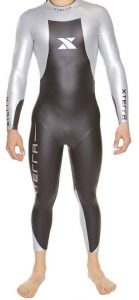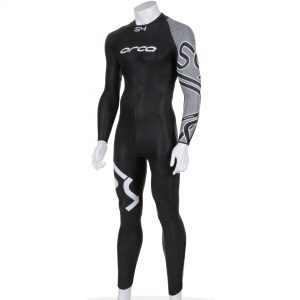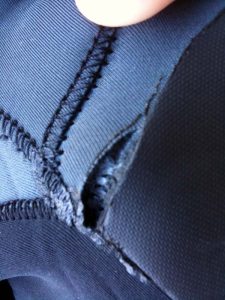Von Collins is an accomplished triathlete and endurance cyclist, and the author of four fitness and training books: Smarter Running, Your First Triathlon Guide, Fit Foods, and 30 Rut-Busting Workouts. He has been cited as a triathlon, cycling, and fitness expert by Healthline, CNET, Forbes, Eat This, Not That and other major outlets.
Buying a wetsuit means you’ll have to navigate through a labyrinth of brand marketing and buzzwords in order to make a selection that’s right for both your ambitions and, not to mention, your budget. While there are plenty of wetsuit options for experience, expert triathletes, the majority of wetsuits sold are geared more toward beginner and intermediate levels.
We all want the best triathlon wetsuit we can get for our particular budget, but where do you begin?
It can be tempting to simply go for a cheap or discounted tri wetsuit, but there is more to the decision than that. A bit part of buying the right suit is matching your needs to the purchase. That is where there is as much art as analysis involved.
Here’s what to look for when investing in a wetsuit, whether it’s your first purchase or not. If you buy the right wetsuit for you, it should an investment that you can use for years to come.
What To Look For in a Triathlon Wetsuit
Fit

Let’s face it – wetsuits fit tight, and they aren’t the easiest thing to get into and out of. That is how they are supported to be — think “snug”, but not constricting. One thing to remember is that while dry land comfort is important, neoprene expands when it gets wet. Your suit will feel larger once you get in the water. High-end wetsuits, especially, fit like a second skin and can really be difficult to get into.
When choosing a wetsuit, it is really important to be sure that the fit leaves nothing to be desired. You might want to research or even try on various brands, since the cuts vary slightly from make to make. The correct suit size will be tight, but not painfully so. Ideally, there shouldn’t be any pockets or air spaces between the suit and skin – the area around the small of the back is particularly prone to this problem. If the suit is too loose, water will gush in underneath and it will lose much of the insulating effect.
Range-of-Motion
Related to fit is the range-of-motion afforded by a wetsuit. Think about what you will be doing in your wetsuit — swimming in open water, in a race that you have trained for for months. You want to be sure that your swim stroke is not terribly altered by the presence of a wetsuit. To do this, be sure you have a suit that allows your arms and shoulders to do a normal, full swim stroke without pulling down on your limbs. If the wetsuit is too constricting, at best you will have sore shoulders after the race. At worst, you will alter your swim stroke and compromise your speed.
Note that sleeveless wetsuits, while not as warm or buoyant, sometimes allow for better overall range-of-motion.
Material (Neoprene)

Neoprene is the fabric marvel that makes your wetsuit both buoyant and warm. Neoprene is a synthetic rubber with thousands of tiny air pockets incorporated throughout. These air pockets give the wetsuit its buoyancy, and they also make for great insulation, helping to retain your body heat in cold water.
However, not all neoprene is the same. Yamamoto Neoprene is generally recognized as the highest quality neoprene available. It is made by a small factory in Japan with a unique limestone-based process that allows the factory to produce very thin neoprene that still retains superior buoyancy and heat retention. Yamamoto Neoprene is a staple in many top-end wetsuits, and used in sections that are as thin as 1.5mm. Less expensive suits will use thicker, bulkier neoprene – up to 5mm in thickness.
Two types of Yamamoto Neoprene are in use today in triathlon wetsuits: #39 and #40. Yamamoto #39 has been widely used for a number of years. Its buoyancy and durability have helped cement the reputation of Yamamoto fabrics in triathlon circles. More recently, Yamamoto #40 has begun to appear on high-end wetsuits. This fabric boasts superior “stretchiness” compared to #39. Previously, #40 was exclusive to Quintana Roo, but it has now found its way to some of the other brands. Generally speaking, the high-end wetsuits on the market have a very precise blend of #39 and #40 neoprene.
Buoyancy
Wetsuit buoyancy isn’t just about type of fabric used. It’s also about where it’s placed in the suit. Most suit makers incorporate extra buoyant fabric panels in key areas, like the butt and lower back. Taking this idea further, some wetsuit companies like Orca and BlueSeventy are now tuning suit performance, making different suits for different types of swimmers. For example, BlueSeventy markets both neutral and positive buoyancy suits. Whereas neutrally-buoyant suits aim to minimize drag by providing a sleek and low profile suit, positively-buoyant suits incorporate extra floatation in the butt and calf areas to help lift the lower body in the water. This extra buoyancy can be quite helpful if you don’t consider yourself to be a technical swimmer as it improves swim posture. Some suits even add extra buoyancy to the chest panel as well, which can be a real aid to those who don’t consider swimming to be a strength.
Texture
Many suits also incorporate a textured forearm panel. The purpose of this panel is to improve stroke power as your arm pulls through the water. On high-end suits, these panels are molded neoprene. Entry level suits will use an appliqué that is either painted on glued on.
While texture is really driven by the materials and neoprene used, it can be a factor that for some buyers make a different in the buying decision.
Zippers, Cuffs, Collars, and Seams

These are the creature comforts of your wetsuit, and can make all the difference between whether you’re going to love or hate putting on the suit. Cuffs and collars should lay flat and be comfortable, but snug, to prevent water from rushing in to the suit. Loose collars tend to rub against your skin and chafe. Nearly all triathlon-specific wetsuits now have flat locked seams, which are again much more comfortable reduce chafing.
Poor seam construction is the kiss of death on wetsuits, stay away from ultra-cheap suits that will likely rip. Buying a knock-off wetsuit might seem like it saves a lot of money, but the seams are usually the first thing to go, and way too quickly.
In general, zippers should easily move up and down when pulled on, but also stay in one place when they should. Some makers such as Xterra are known for their 2-year guarantee on items like zippers and seams. This is a useful feature for the athlete looking for gain a few seconds edge during the transition.
Cost
At the end of the day, perhaps the most important feature for many would-be wetsuit buyers is price. The key point on price is value — you want to get the best wetsuit for the money, regardless of what your particular budget tends to be. (this should be true for all of your tri gear — think of it all as a long-term investment). Entry-level wetsuits start at around $150, and top-of-the-line models can fetch over $600. Mid Range suits are often the best bang for your buck. While entry level suits are very basic in design to order keep a low price point, mid range suits are all about value. Many of the features on today’s mid range suits were found just a few years back on only the high-end suits. Finally, remember to keep things in perspective –a good suit will complement the hard work you’ve put into training, but not replace it.







